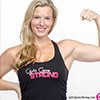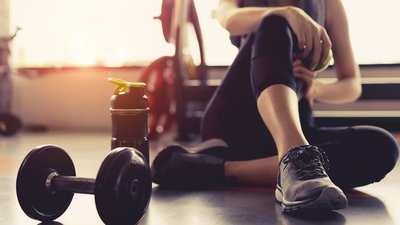#MeToo is a movement, but it's also a moment. Or more specifically, it's countless individual moments that may sound shocking at first read, but have a certain familiarity to them the more you listen. And the fitness and health industry has been no exception.
Consider this situation: A scientist and speaker found herself sharing the bill at a conference with a well-respected male nutrition educator, who was slated to give the keynote address. She knew his work and had cited it a number of times, but had no other history with him. As is often the custom at these sorts of events, both people were at a group dinner. But within minutes of sitting down next to him, the scientist was dismayed to find the man running his hands through her hair, whispering vulgar things in her ear.
Her response was direct: "Dude, you're nice and all, but that's not what I'm here for. Please stop." He did…for about 30 seconds. Then it started again: the touching, the comments, the unwillingness to stop or listen to her. The scientist texted friends, and mouthed "save me" to people she saw in the restaurant. Then, as soon as she had the chance, she left the booth and reported the nutritionist immediately to the event organizer.
In this particular case, the nutritionist was removed from the program, and in the ensuing days and battles-in-the-comments on social media, things only got messier. It became clear that the scientist was far from the only woman who had experienced forceful, unpleasant advances from the nutritionist, and that he had a history of trying to discredit women who spoke out about his behavior.
Stories related to this particular situation came to light, and plenty of others that weren't "related," but echoed its basic pattern among trainers and clients, gym members, or elsewhere in gym culture. And for many of us, this discussion and ones like it felt like they were a long time coming.
As a result of increased discussion on these topics, plenty of folks want to understand the issues better. Many guys in particular are asking themselves whether they are a part of the solution, or a part of the problem. Dozens of men have come to me asking what they can or should do differently.
It all starts with simply listening. As the co-founder of the online fitness community Girls Gone Strong, I'm in a unique position to hear from women who have experienced the dark side of what could be called fitness "rape culture." Here's some of what women have told me recently, and what you, the men and women reading, can do to help.
A Long Time Coming
A moment ago, I stated that the #MeToo movement has been a long time coming. Here's why: Sexual harassment and assault are incredibly pervasive, and behavior that used to get swept under the rug or dismissed as "normal" or "just the way things are" is no longer being tolerated.
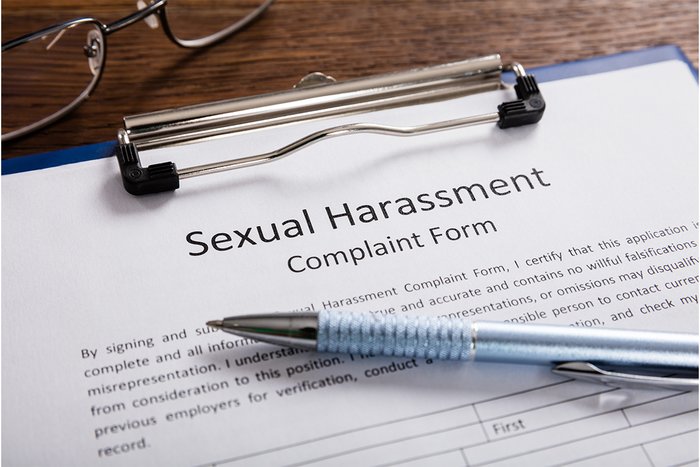
In a 2018 survey, 81 percent of women reported experiencing sexual harassment.[1] That's double the rate of men. These experiences include, but are not limited to:
- Verbal sexual harassment (e.g., catcalling)
- Unwelcome sexual touching (e.g., grabbing their butt)
- Cybersexual harassment (e.g., lewd messages)
- Being physically followed
- Unwanted genital flashing (e.g., "dick pics")
- Sexual assault
Globally, 35 percent of women are sexually assaulted or raped in their lifetime.[2] Sadly, the actual numbers are likely far higher than this considering that sexual violence is very under-reported.
Those numbers may seem high—even to women. But here's one of the great unspoken truths about being a woman: Most of us, in fitness culture and elsewhere, are already altering our behavior in both small and large ways in order to keep ourselves out of harm's way. In fact, this even has a name: a "rape schedule."
Rape schedule is the term used to describe the conscious and subconscious ways women place restrictions on themselves and/or alter their daily behavior as a result of their constant—and not always completely conscious—fear of sexual assault.
I recently posted a question on the Girls Gone Strong Instagram stories, asking women what they do daily to try and protect themselves from sexual harassment and assault. Within 24 hours, I had more than 250 responses. Here are some of their answers:
Gym-related "rape schedules":
- Avoid wearing tight or revealing clothes to the gym so I don't attract attention
- Try to go to the gym when it's not busy so the guys don't leer at me in the weight room
- Changed my gym schedule to avoid another creepy gym member
- Don't go to the workouts where men are coaching; only go to the women-led classes
- Wear track pants over my gym shorts when I walk to the gym to decrease harassment
- Wear my headphones on my 10-minute walk to the gym so I don't hear catcalls
- Switched gyms because the walk to my gym passed by a construction site and I was constantly harassed
- Switched gyms because the manager always commented on my body in ways he thought were "compliments," and I didn't think anyone would believe me if I told them
- Stopped going to the gym altogether, and work out at home now even though I can't train as hard
- Switch my workouts so I never have to deadlift or hip thrust when the gym is busy
As you can see, these aren't small concessions. They're significant changes to the way women train and live. It affects what they wear, what exercises they choose, what time they train, who they're willing to ask for a spot—even if they're willing to train in a gym at all.
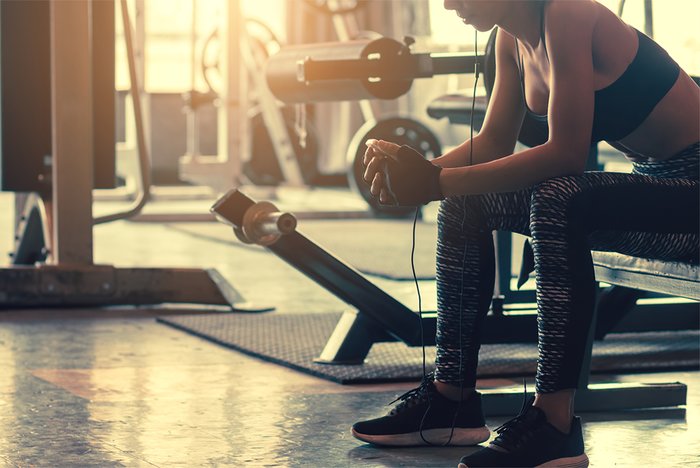
And in the end, it makes it harder for them to work out how they want, harder to see results, and harder to see and feel the positive results of an active life. Even women who love training can simply find themselves exhausted and worn down by all they have to put up with.
And this is just at the gym! With a little prodding, most women can also point to ways they maintain a rape schedule in their daily life. Just a few include:
Not gym-related "rape schedule":
- Never drink alcohol unless I'm in the presence of trusted friends
- Only wear headphones in one ear to maintain awareness when I'm in public
- Choose my clothing carefully when I know I have to walk on the street more than a few blocks
- Look men I'm passing on the street directly in the eye, with a very stern expression
- Avoid eye contact with men on the street entirely
- Repeat to myself three times what any man passing me on the street is wearing so I can remember identifying characteristics
- Call my partner/mom/friend anytime I'm walking at night and let them know my location so they can call for help if I need it
- Check the back seat of the car every time I get in
- Park in well-lit areas, and refuse to park and walk in dark areas
- Don't schedule night classes in college so I don't have to walk alone at night
- Ask a male manager to walk me to my car at night when I leave work
- Avoid working late at my office when I know a creepy male co-worker is also working late so I don't have to be alone with him
- Never get on an elevator alone with a man
Yes, sexual harassment and assault can happen anywhere. But make no mistake: It's happening within the fitness industry every day.

I asked women in the Girls Gone Strong community about their experiences and received hundreds of responses. Among the many experiences, our community members reported:
- Being catcalled, leered at, and repeatedly hit on while working out
- Hearing men in the gym, including fellow trainers, using degrading language about women and telling rape jokes
- Receiving "jokes" about being videotaped in the gym shower without their consent
- Being attacked and sexually assaulted while working their job in the gym
I hope you agree that none of that is OK.
What You Can Do
At Girls Gone Strong, we're always working to help create a culture where all women feel comfortable, safe, and empowered in their lives and in their bodies outside and inside the gym. But we can't do it alone.
We need men to actively help us stop this problem. Industry-wide change can't occur until men recognize and begin shouldering the burden of ending sexual harassment and assault.
For many men, this means making a change, and being willing to be honest about where we're at right now. Of course, some men are more ready, willing, and able to seek change than others, when it comes to actively preventing and stopping harassment and sexual assault.
Just as we might think of clients as being at different fitness levels, I've characterized this readiness to create change in three tiers. I've found that understanding these tiers can help guys get a sense of where they stand, and where it's possible for them to do better.
Tier 1: The Guys Who "Get It"
These guys understand that sexual assault and harassment are incredibly common, and believe the onus of responsibility is on men to fix the problem.
When women speak about harassment and assault, they listen. They understand that their experiences are probably very different from women's and they actively seek ways to support women and to create safe, harassment-free environments.
These are the guys who speak up when they witness other guys perpetuating sexist or harmful ideas and behaviors.
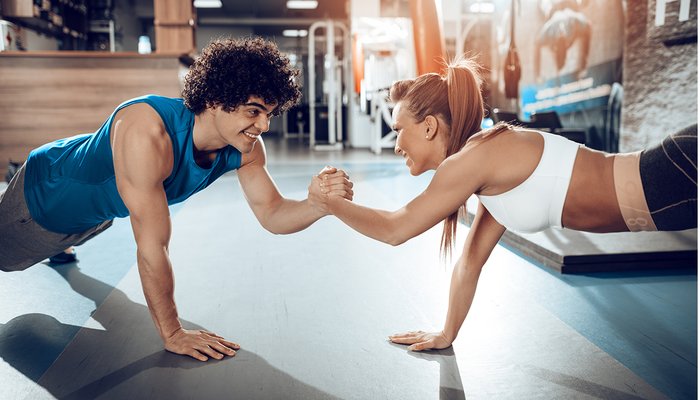
Tier 2: The Guys Who Don't Get It, But There's a Chance They Will
These guys understand that sexual harassment and assault happens, but they don't realize how common it is. They are surprised when they hear statistics, and they may even be surprised when they learn that a woman they know has been assaulted. When women speak about harassment and assault, they share their opinion, too.
Tier 3: The Guys Who Don't Get It, And It's Likely They Never Will
These guys believe that sexual harassment and assault happen, but they think the whole thing is being blown way out of proportion. They may be the guys who assert that some women are lying, are opportunists, or are manipulating a situation because it didn't turn out in their favor.
It's important to consider where you fit in this picture.
To be clear: Tier 1 guys are the guys who are going to help us make real change. They have the potential to change the fitness industry and make women's lives—heck, all our lives — better by preventing sexual assault and harassment.
Learn How to Make a Change
If you're not happy with where you fit in these tiers, keep in mind it doesn't necessarily mean you're a "bad guy." It means you have an opportunity to do better. But it is also your responsibility to get better.
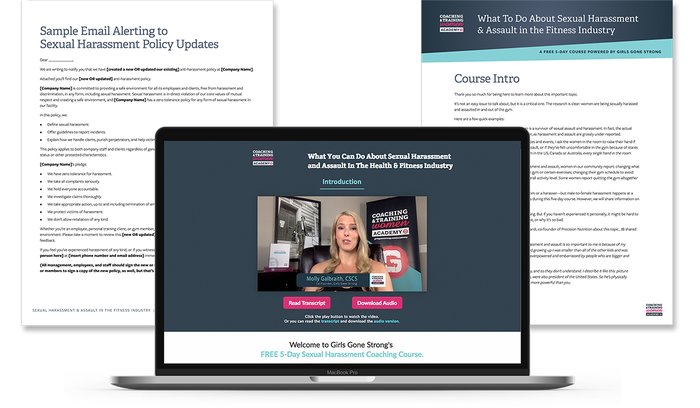
The good news is this: Change is totally possible. You can move from a Tier 2 or 3 guy to a Tier 1 guy, and you can be a powerful catalyst for change. Want to start? It can be as simple as adding a moment of reflection where there otherwise wouldn't be one. Think twice before speaking or acting. Listen when the opportunity arises. And actively seek out opportunities to learn.
Here's a great place to start. Enroll in Girls Gone Strong's free five-day course, What You Can Do About Sexual Harassment and Assault In The Fitness Industry.
This covers critical topics, including:
- How to identify behavior that seems OK, but really isn't
- How to avoid common mistakes guys make (even when they think they "get it")
- How to create a safe, welcoming environment for clients and patients
- What you can do to stop sexual harassment and assault in your gym and in the fitness industry
- How you can be part of the solution, not the problem
We'll also include case studies and sample scripts to help you understand:
- What to do if you witness or suspect sexual harassment in the gym
- What to do if a woman confides in you that she was harassed
- What to do if you experience harassment personally
You'll leave this course with a set of actionable tools and a clear path forward.
References
- 2018 Study on Sexual Harassment and Assault. (2018, February 21). Retrieved from http://www.stopstreetharassment.org/resources/2018-national-sexual-abuse-report/
- Violence against women. (n.d.). Retrieved from http://www.who.int/news-room/fact-sheets/detail/violence-against-women
